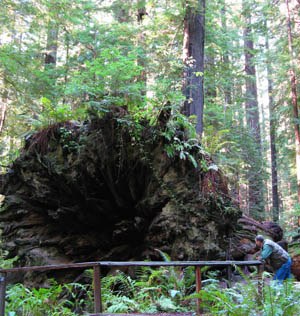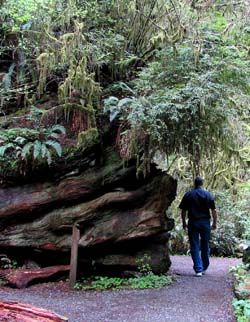
The Achilles' heel of redwoods
Self-destruction to roots & tissue by extreme weight
Are the drive-through redwoods actually safe?
by Mario D. Vaden
After looking at a lot of fallen redwood logs hollow under the base, and estimating the weight of live redwood titans, my hypothesis is that giant redwoods self-destruct their own root system tissue. A type of Achilles'-heel.

Apparently, a coast redwood like Lost Monarch with 42,000 cubic feet of wood, will weigh in the range of 2,500,000 pounds.
A site called the Engineering Toolbox, lists redwood at 50 lbs. per cubic foot. It we multiply Lost Monarch's 42,000 cubic feet x 50, we end up with 2,100,000 lbs. But that does not include all the branches, twigs, foliage, epiphytes and rainwater when saturatated. So 2,500,000 pounds would be a fair estimate for the peak weight during rainfall.
One of the largest known coast redwoods, the Lindsey Creek Redwood, would have weighed as much as a Saturn V rocket, in the range of 4,000,000 pounds.
My hypothesis is that weight of old redwoods causes so much pressure beneath the trunk, that the soil beneath is compacted and cambium growth on the underside is halted. This in regards to the oldest: 700, 1500 or more years in age. The cambium is the living thin layer under the bark where cell division occurs.
You may have seen how thin cambium can be if you ever scratched the outside of a young plant stem before, revealing some green tissue beneath. The cambium of a giant redwood is not really thicker than the cambium of of a small redwood. Virtually paper thin, like card stock.

advertisement
A giant redwood is cloaked around its exterior beneath the bark with a thin living "skin" that expands with new cell division, adding girth to it in all directions. The vascular cambium is always moving outward, and it yields tissue growth in two directions, inward and outward. As the cambium grows away from the center of the redwood, it makes and leaves behind it on the inside, more wood or xylem. Simultaneously, it makes and builds more phloem outside of it, just under the bark.

That is, of course, unless something blocks it.
A redwood like Lost Monarch exerts downward roughly 240 to 280 pounds of pressure per square inch due to its own weight. Let me explain ...
A titan like Lost Monarch weighs about 2,500,000 pounds. It It is nearly 26' diameter at DBH, but its footprint on the ground is 28' to 30' wide. 30' diameter = 707 square feet, or 101,808 square inches. 2,500,000 pounds divided by 101,808 square inches = downward weight pressure of about 245 psi. And 280 psi for a 28' wide footprint.
That's like stacking about 1400 bags of concrete over a 30 inch x 50 inch area the size of a table top. Or like stacking over 35 pallets of concrete one on top of another in a tall column of crushing weight. For a redwood like the Lindsey, the pressure would be comparable to 50 pallets of concrete stacked in a column: up to 450 psi.
That kind of pressure on the underside of the root plate is comparable to redwood roots trying to heave a non-reinforced sidewalk over 40 - 65 feet thick. Redwood roots generally can't even lift the side of a hollow 2 story house with some furniture. This great pressure must be a factor limiting the future stability and lifespan of redwoods.
Researching, I found that some roots can exert up to 175 psi (www.isa-arbor.com - ISA Arborist News 2001 Vol. 10, No. 3, pp. 21 - 24). And there is no way that 175 psi of exerted root pressure will stand a chance against 280 psi of downward pressure. The root pressure is outmatched by the tree weight.
A little bit of weight will be distributed beyond the trunk to some roots, but most of it will go straight down. If a redwood is hollow in the middle, the the psi skyrockets. Like when redwoods get goosepens in the middle from fires or decay. If the center is open like a hollow room, then all the weight presses down around the perimeter. The psi could be double or triple. If Lost Monarch had a hollow goosepen, for example, the pressure along the edge could be 600 psi. If the Lindsey Creek redwood had a big goosepen, then 1000 psi for it. Lindsey redwood may never have been able to stand as long as it did, with a goosepen.
Redwoods can exert quite a bit of pressure at times when the conditions are right, but there are limits. The skinny thin layer of cambium is only so thick and powerful. Much of the inner trunk tissue is not living. Its merely the outer living layer of cambium that exerts pressure outward. So it does not matter how massive a trunk is, the cambium is still sort of a weenie.

Again, the cambium moves outward producing a layer of wood toward the inside where it just left, and at the same time produces some phloem and bark ahead of itself as it pushes outward. That's one reason bark cracks and furrows, from this living layer underneath that advances outward, leaving tissue behind itself and ahead of itself.
It does not take much of an obstacle to constrain or constrict cambium growth. Cambium growth on tree roots for example, may be able to lift a sidewalk a few inches thick weighing several hundred pounds, but it won't be able to lift a sidewalk of concrete several feet thick.
That's why you may find a big tree that cracked the foundation of a single story house floor slab, but not one that lifted the side of a two story house.
At some point, even a redwood can't produce cambium tissue when pressure reaches a certain threshold. And with redwoods, they have enough weight at old age to restrict their own growth. Probably causing their own soil compaction too.
The aggregate photograph to the right shows just a few examples of how cambium and phloem tissue can be constricted and stopped from expansion. Look at the first image. See how a small branch that was not pruned away, was enough to stop the tree from expanding tissue outward? The cambium did not have the energy to force and bend the limb out of the way. Next - the second image. That's where a bigger stem of a flowering plum was removed. See how the two stems expanded and met in the middle, preventing each other from expanding on the inside? It left a flat-sided area where no cambium could grow and expand. In the third image, the root of a white birch encircled it's own trunk on one side, stopping its cambium and tissue from expanding. The fourth image is a bit similar to the second image, where two small stems grew and became big stems that constricted growth in-between. The fifth image is a metal hook someone hung in a flowering cherry to hang a plant. See how the cambium failed to have energy and power to bend the metal out of it's way?
Same relates to redwoods, their cambium is not much stronger. Underneath the living stumps or root plates, the tremendous weight of hundreds of thousands or millions of pounds should easily produce enough pressure to constrict or kill cambium tissue.
In addition, if the weight of the redwood compacts the soil beneath, that means that exchange of gasses like oxygen and carbon dioxide will be minimal, affecting the redwood tree and microorganisms.
A of visual evidence provided by living trees connotes that redwoods self-destruct their own tissue beneath during old age.
The effects of the weight may be at least two-fold. One part is the pressure from the weight on the cambium tissue underneath the root plate. The other aspect is potential soil compaction affecting the movement of water and air in the soil.
Reduced air exchange in soil can also negatively affect the health of mycorrhizal fungi and other microorganisms that live with the roots of redwoods.
The weight of a titan redwood over a potentially deteriorated root system may even lead to something similar to liquefaction experienced under buildings during severe earthquakes.
The top photograph on the page is Dyerville Giant, now one of the longest redwoods in the world. It used to be one of the tallest redwoods in the world. Likewise, you can see the concave middle beneath.
This redwood is in the Founders Grove along the Avenue of the Giants close to where Bull Creek meets the Eel River - south of Fortuna, California.
The middle photograph on the page is the bottom end of a fallen redwood at Simpson Reed Discovery Trail. The bottom, as with many fallen redwoods is concave and partially hollow beneath: typical for deterioration prior to falling. This log should be around for centuries. The Simpson Reed trail is a great little redwood stroll through the woods, and might be one of the best trails if someone is in a wheelchair.
About drive-through redwoods, and are drive-through redwoods safe? Chandelier, Shrine or Drive Thru redwoods: are they a hot idea in the long-run? With the middle carved out, the psi on the remant sides of the trunk is doubled or tripled so that a redwood like Chandelier may have pressure on its sides as if it were holding up Lost Monarch. Plus the wood grain has been exposed on the inside, furthur weakening the redwood to splitting or cracking when wind gusts rock or oscillate the canopy. There is about a 50% chance that one of those drive-throughs will collapse during daylight hours. And with peak business season lasting about 1/3 of the year, I predict a 10% chance that one of those tourist attractions may collapse when cars pass are parked beneath.
Redwoods like this seem really odd to deal with, because how do you know for certain whether or not they will topple? The chance of eventual collapse is 100% by some point in time. My guess for those 3 drive-through redwoods is that the Shrine redwood in Myers Flat will go first, the Drive-Thru redwood in Klamath second, and the Chandelier redwood last. It would be a surprise if the Shrine redwood lasts until 2020.